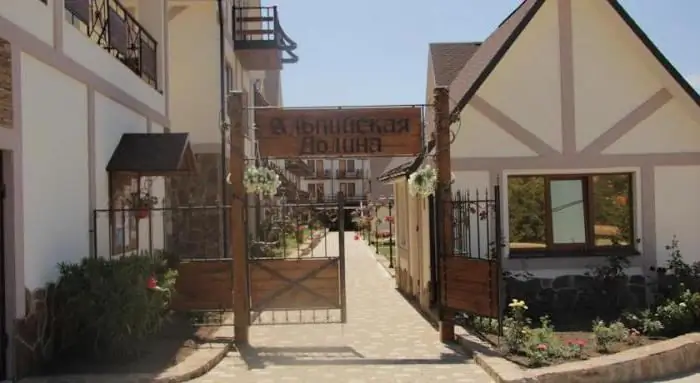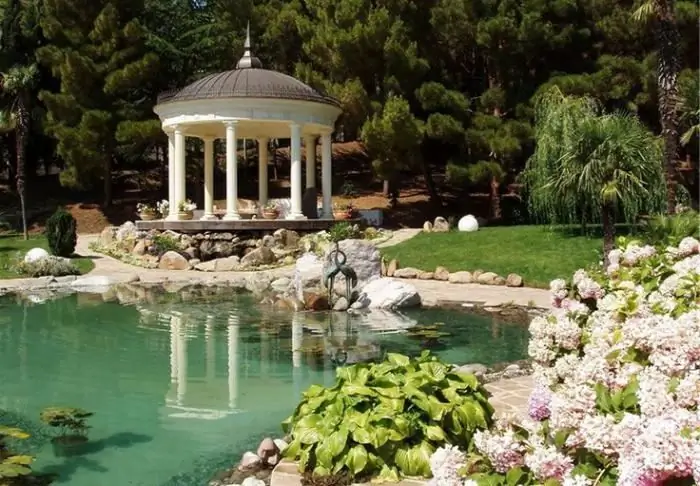- Author Harold Hamphrey [email protected].
- Public 2023-12-17 10:06.
- Last modified 2025-01-24 11:10.
The resort town of Alushta on the southern coast of Crimea is famous for its convenient coastline and various attractions, both man-made and natural. In the vicinity of the mountains, extended caves were formed, washed out millions of years ago by sea water. Every year they are visited by numerous excursions. Actually, the caves of Alushta are the main topic of this article.
Crimea, despite all the political strife, remains a favorite vacation spot for many Russians. The thousand-year history of the peninsula, combined with geographical and climatic features, annually attracts millions of tourists to these parts.
Rest in Alushta
It is worth talking directly about the rest in the resort town before proceeding to the description of the caves of Alushta.

Located between the Kebit-bogaz and Angarsky passes, the city is located in a favorable climatic zone. These hills provide the territory with warm air mass flows from the sea to land and vice versa.
The coastline consists mainly ofnatural beaches, the length of which is about forty kilometers. A large number of different boarding houses, recreation centers, hotels and hotels offer a wide range of services for a pleasant stay.
Here you can have a great time in the local dolphinarium, water park, amusement park, as well as in bars and discos. For outdoor enthusiasts, it will be interesting to follow the excursion routes to the mountains and local caves. Historical sights dating back to the 6th century and later buildings will not leave vacationers indifferent.
Mount Chatyr-Dag
It is more of a mountain range than a single mountain. Spread out in length for 10 kilometers and in width for 4.5 kilometers, Chatyr-Dag consists of such rocks as sandstone, silt and limestone. It is interesting that the mountain is formed as if from two layers. The lower layer is harder, and the upper layer is limestone, about a kilometer thick. It is this feature that determines the presence of a large number of karst caves in Alushta.

Every year, the Chatyr-Dag mountain range receives about 50 thousand tourists. This is due to the fact that it is quite easy to get here. There are more than two hundred caves here, and more than a thousand sinkholes have been discovered.
The most popular Chatyr-Dag caves in Alushta are located on the lower plateau of the mountain. These are the Marble, Emine-Bair-Khosar, Emine-Bair-Koba caves equipped for descent, as well as the so-called wild caves of Suuk-Koba, Bin-Bash-Koba and others.
How to get to the caves from Alushta? It is noteworthy that through the passAngarsky paved the way for the longest trolleybus route in Russia. Thus, the mountain can be reached by public transport from Simferopol or Y alta, as well as from Alushta itself. From the stop follows a tourist beaten path, and the walk takes about an hour. Having at your disposal your own transport, you can also go to the yayla itself - a summer mountain pasture. The main thing is to be careful, because the massif is dotted with karst funnels.

Marble Cave
Contrary to the name, there is absolutely no marble there. Geologists say these mountains were only a few hundred million years short of being formed in marble rocks.
The question of how to get from Alushta to the Marble Cave is asked by many vacationers. It turned out to be very simple. First you need to get to the village of Marble, from where you can then drive directly to the "Marble" partnership and further along the dirt road following the signs.

So, the entrance to this cave is located at an altitude of 918 meters above sea level. It is located on three tiers with a length of about 2 kilometers. It was discovered in 1987 and after a couple of years "opened its doors" to tourists.
A large number of huge halls are very often covered with stalactites and stalagmites in the form of figures of people, animals, birds and plants that amaze the imagination. Multi-colored illumination creates the impression of being in a fairy-tale land. In a word, all this must be seen with your own eyes. However, not every room is equipped. Some evenrequire physical fitness and speleological experience to visit.
Emine-Bair-Khosar Cave
Or, as it is also called, Mammoth Cave. It got its name because of the discovery by speleologists of a baby mammoth in one of the halls. Other remains of animals from the Ice Age were also found in it. Subsequently, it was decided to make a natural mineralogical museum-reserve of the Crimea out of the Mammoth Cave. Next to it are the Emine-Bair-Koba cave and the Marble Cave, the distance from Alushta is about 10 kilometers.

The cave was discovered in 1927, but as a tourist site it began to exist only in 1999. And in 2005, the Kecskemét Hall was opened to the public. The length of the cave is about two kilometers, but only one kilometer is open to the public. The isolation that existed in the past was created by people to preserve the natural beauty and protect against looting, as happened with other caves. Many of them were destroyed and mutilated.

Emin-Bair-Koba Cave
Emine is a beautiful female name, Bair is a hill, and Koba is a cave. The people also call it the Three-eyed because of the equal size of the three arches-entrances. This cave is slightly smaller than its neighbors. The total length of the halls is about 950 meters. However, only the first 200 meters are open for visiting, and only 70 meters of equipped halls are available for ordinary tourists, the rest requires special equipment and training. But the brave ones are waiting for a truly generousthe reward is the opportunity to admire the transparent cave lakes at the end of the path. Their depth is about 8 meters, but it seems as if you can touch the bottom with your hand.
Suuk Koba Cave
The literal translation of this name is "cold cave". In fact, this is a wild cave, and no entry fee is required here. It is disguised by the greenery of trees and is located in a small hollow in the Chatyr-Dag mountain. You must first stock up on light sources. The depth of the cave is a little more than 40 meters from the entrance, and the length is about two hundred meters. Large halls up to 20-25 meters high are amazing.
The cave was discovered back in the 19th century, and since that time much has been looted for souvenirs, destroyed and mutilated. In the last century, a film crew from Bulgaria filmed scenes for the movie "Stinger" in this cave. Even now you can find color images that imitate the drawings of a caveman.
Binbash-Koba Cave
It is curious that many caves have a second, popular name. So Binbash-Koba, which translates as "The Cave of a Thousand Heads", has another name - the Thousand-Head. It was given to her for a reason. Inside were found the remains of human bones and numerous skulls. Here is what a traveler of the early 20th century writes about this place:
"Bim-bash-koba", which means: "The Cave of a Thousand Heads". Leaning under a very low vault, with bundles of candles in our hands, we made our way into its depths. Candles did not disperse the dense, almost palpable darkness of this dungeon. At the top it hung impenetrable and heavy, andbelow, on the stone floor, a heap of human skulls shone before us with phosphorescent whiteness, in which the black hollows of the eyes gaped. They say that in recent years there have been few of them left: human curiosity does not stop at nothing, and soon careless tourists will finally take away this sad landmark of Chatyr-Dag. But at that time there were still amazingly many of them … After a bright day, after the sparkling play of the boundless sea, after careless conversations and laughter - this abundance of silent death in a dark dungeon captured the gloomy tragedy of secrets … How many of them were and what death horror these people, driven here by an unknown thunderstorm of an unknown, dark antiquity?..
According to legend, a whole tribe died here, fleeing their enemies. How exactly this happened remains a mystery. However, the very realization that the cave is actually a cemetery is terrifying.
Kyzyl-Koba Cave
The largest Crimean cave near Alushta has its second name "Red Cave". It is located on the spurs of the Dolgorukovskaya Yayla, three kilometers from the village of Perevalny. It is called the largest for a reason. The length of all the halls is about 25 kilometers with a height difference of up to 275 meters. Huge, they reach a height of up to 145 meters. And in length - more than 70 meters. For example, as the "Hall of the Blue Drop". Being inside, people are really amazed at such a scale. The complex underground labyrinth consists of 6 tiers and covers an area of 33 hectares. However, despite the grandeur of this natural monument, foronly 500 meters of the excursion route are open to tourists.

The underground river Kizilkobinka makes its way through the cave on the first floor. It, flowing out of the entrance, forms the Su-Uchkan waterfall. Inside you can find a large number of lakes, waterfalls and siphons. Here is one of the largest stalactites in Europe, which reaches a height of 8 meters. Its age is more than 8000 years.






